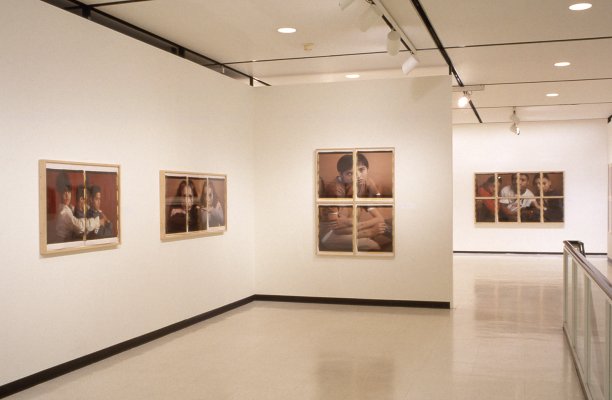Dawoud Bey: Portraits 1975–1995
Saturday, January 13, 1996–Sunday, February 25, 1996

Installation view of Dawoud Bey: Portraits 1975–1995. Photograph by Tom Loonan.
1962 Building
According to American photographer Dawoud Bey, he wants the subjects of his portraits to possess “the power to look, to assert oneself, to meet the gaze of the viewer… to reclaim their right to look, to see, and to be seen. I like to give this attention to black people, as a people whose images have been stereotyped and ridiculed extensively in this country.” Dawoud Bey: Portraits 1975–1995 was organized by the Walker Art Center in Minneapolis and presented a 20-year survey of more than 90 images focusing on the artist’s developments in the genre of portraiture. The exhibition examined Bey’s move from the traditional format of black-and-white silver prints to his fascination with the possibilities of large-scale color Polaroid film.
Born in Queens, New York in 1953, Bey’s earliest photographic explorations evolved into a five-year project documenting the people and streets of Harlem. Entitled Harlem USA (1975–1979), the series is a collective portrait of a place and its inhabitants, very much in the documentary tradition of the Farm Security Administration (FSA) and photographers such as Margaret Bourke-White and Walker Evans. The series was shown at the Studio Museum in Harlem in 1979, Bey’s first solo exhibition.
For most of the 1980s, Bey continued working within the tradition of “street photography,” capturing the urban landscape and the black populations of cities such as Rochester and Syracuse, New York; Washington, D.C.; and New York City. By the late 1980s, Bey found himself becoming self-conscious about his position as a photographer in often-depressed communities. He felt he was taking a lot from his subjects and wanted to find a way to return their generosity. Bey began working with a 4-by-5 inch view camera, setting it up on a tripod in the street. Using Polaroid technology, he was able to give a photograph to each of his subjects instantaneously and still have a useable negative for printing. From 1988 to 1990, he developed this process and style, resulting in a hybrid between street photography and portraiture — a type of formal outdoor portrait.
In his mid-1990s color studio portraits with the 20-by-24 inch Polaroid camera, Bey used multiple photographs to create a single work. In his double portraits, or diptychs, the subject is presented in two very different ways. He also expanded the portraits to three-, six-, eight-, and 12- paneled pieces. The majority of his models are teenagers, and through them he captures American youth culture, in an urban-style that is paraded in clothing, gesture, and body language. His subjects use the arena of fashion and their own bodies to construct places and reflections of personal power. Bey commented, “My use of color has to do with wanting to make an unabashedly lush and romantic rendering of people who seldom receive that kind of attention.”
In conjunction with this exhibition, Bey’s work was the topic of a special tour led by the artist and Senior Curator Cheryl Brutvan on “Buffalo News Family Day.” The Walker Art Center also published a catalogue of Bey’s work, including an essay by Kellie Jones and an artist interview with Jock Reynolds, Director of the Addison Gallery of American Art, Andover, Massachusetts, and additional contributions by photography critic A.D. Coleman, and novelist-poet Jessica Hagedorn.
This exhibition was organized by the Walker Art Center Adjunct Curator Kellie Jones, and Senior Curator Cheryl Brutvan.